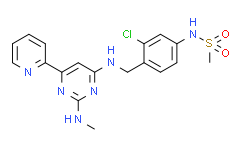| Description: |
TC-G-1008 (GPR39-C3) is a potent and orally available GPR39 agonist with EC50 values of 0.4 and 0.8 nM for rat and human receptors respectively. |
| In Vivo: |
Rat and mouse plasma protein binding for TC-G-1008 is measured as 99.3% and 99.1%, respectively. TC-G-1008 is orally bioavailable in mice and robustly induces acute GLP-1 levels. Upon single oral doses of 10, 30, and 100 mg/kg of aqueous suspensions in 0.5% methylcellulose/0.1% Tween 80, TC-G-1008 achieves, between 1 and 1.5 h, maximal exposures of 1.4, 6.1, and 25.3 μM, respectively[1]. |
| In Vitro: |
TC-G-1008 shows selectivity over a panel of kinases (IC50s>10 μM) and does not exhibit relevant binding affinity for the related ghrelin and neurotensin-1 receptors (IC50s>30 μM)[1]. In HEK293-GPR39 cells, GPR39-C3, which is a positive allosteric modulator, activates cAMP production (downstream of Gs), IP1 accumulation (downstream of Gq), SRF-RE-dependent transcription (downstream of G12/13), and β-arrestin recruitment. GPR39-C3 induces dose- and time-dependent loss of response in cAMP production by second challenge of the compound[2]. |
| Kinase Assay: |
HEK293-GPR39 cells are plated and cultured in poly-d-lysine-coated, white, 384-well plates (4000 cells/well) in the growth medium overnight at 37°C in the presence of 5% CO2. For pretreatment of the cells with GPR39 ligands (TC-G-1008) or vehicle control (DMSO), the culture medium is removed and the cells are stimulated with GPR39 ligands in assay buffer for the indicated time at 37°C. Then, the compound solution is removed and washed twice with PBS containing 0.1% BSA. For measurement of intracellular cAMP, the cells are stimulated with drugs in stimulation buffer for 30 min at 37°C. The intracellular cAMP level is determined by using HTRF cAMP dynamic 2 kit[2]. |
| Animal Administration: |
Mice: Mice are given single oral doses of 10, 30, and 100 mg/kg of TC-G-1008[1]. |
| References: |
[1]. Peukert S, et al. Discovery of 2-Pyridylpyrimidines as the First Orally Bioavailable GPR39 Agonists. ACS Med Chem Lett. 2014 Aug 4;5(10):1114-8.
[2]. Shimizu Y, et al. Rho kinase-dependent desensitization of GPR39; a unique mechanism of GPCR downregulation. Biochem Pharmacol. 2017 Sep 15;140:105-114. |






















